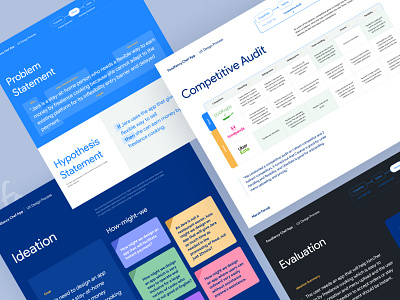UX Design process 2-3 | Define & Ideate | Foodfancy Chef app
Design is not about how it looks, but rather how it works. In every project we work on, we have to be empathetic, pragmatic, and collaborative to get the best user experience possible.
In the UX design process of the Foodfancy chef app, we followed the Design Thinking framework, as we generally approach every design. We prefer the Design Thinking framework because of reasons. 1. It's outlined by Tim Brown 2. the child of Standford University and 3, widely followed by industry pioneers, like Google. So, we can safely say that it's proven for a successful UX.
We followed 5 steps outline for this app:
✅ Empathize ✅ Define ✅ Ideate ➡️ Prototype ➡️ Test
We have uploaded the details of how we went through the Empathy step in my previous shot. Today I want to share with you the next 2 steps, Defining the problem and the Ideation solution.
✅ Define Problem (screen 2):
Problem Statement:
A clear description of the user’s needs that should be addressed.
1. Human-centered
2. Broad enough for creative freedom
3. Narrow enough to be solved by a design
In our case, here is the problem statement:
"Jara is a stay-at-home person who needs a flexible way to earn money by freelance cooking because she cannot adapt to the existing platform for its inflexibility, entry barrier, and delayed payment."
We can think about defining a problem as a hypothesis statement, or a simple if-then statement.
Hypothesis statement:
"If Jara uses the app that gives her a flexible way to sell so that she can earn money by freelance cooking."
✅ Ideation (screen 3):
We conducted brainstorming and How-might-we to generate and explore ideas and place the problem statement in front. The process of generating a broad set of ideas on a given topic, with no attempt to judge or evaluate them.
The goal:
“We need to design an app for Jara, a stay-at-home person- to earn money flexibly by freelance cooking through making the app flexible, low entry barrier and instant payment.”
1. How-might-we:
We came up with some ideas which are on-screen #3 where we brainstormed wild ideas. The only ideas that are feasible are shown on the screen.
2. Competitive Audit (screen 4):
As a part of the ideation, competitive gives us insight into how the competitors, direct or indirect, solve this type of problem the user faces. Green boxed features we like most about our competitors.
The report of our audit is:
"We conducted a competitive audit on 1 direct competitor and 2 indirect competitors. It turned out that Cookup is good for order handling and flexibility, and UberEats is good for onboarding, menu uploading, and pricing."
3. Evaluation (screen 5):
The ideas are not enough if that is not feasible, desirable, and viable. So, The idea which is the best in these 3 parameters was the winner to be tested.
The next steps are coming soon in upcoming shots. 😃
Please suggest to us where we can improve the process👋
🤩 The idea:
Do you believe that the cooking skills are saleable? Well, we do. So we came up with an idea where the people who need homemade foods for lunch or dinner can order another "person" who will make the cooking for them.
✉️ Have a project idea? I am available for new projects and a full-time remote position. Say me hallo at mafruh.faruqi@gmail.com 🔥
Find me on LinkedIn












